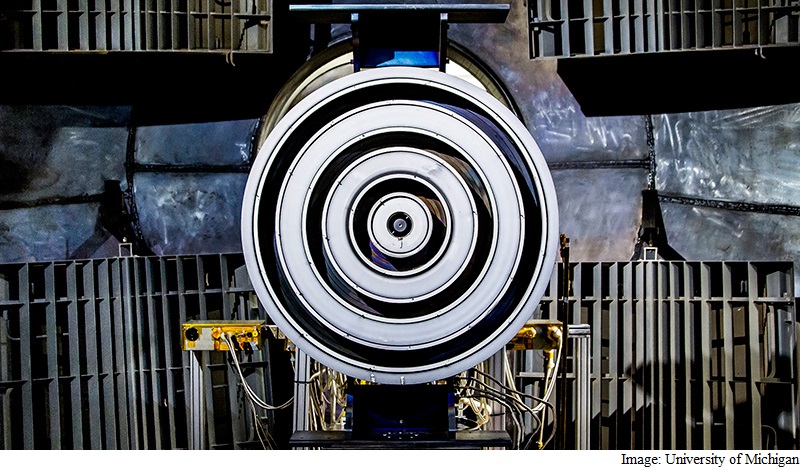- Home
- Science
- Science News
- New Thruster Built With Aim to Propel Humans to Mars
New Thruster Built With Aim to Propel Humans to Mars

Nasa has funded a spaceflight propulsion system to be built around a tabletop-sized thruster developed by Alec Gallimore, the Richard F and Eleanor A Towner professor of engineering.
The US space agency awarded $6.5 million (roughly Rs. 44.5 crores) over the next three years to Aerojet Rocketdyne for the development of the propulsion system, dubbed the XR-100.
Gallimore's thruster, called X3, is central to this system and his team will receive $1 million (roughly Rs. 6.8 crores) of the award for work on the thruster.
The XR-100 is up against two competing designs. All three of them rely on ejecting plasma - an energetic state of matter in which electrons and charged atoms called ions coexist - out of the back of the thruster.
But the X3 has a bit of a head start. For thrusters of its design power, 200 kilowatts, it is relatively small and light.
The core technology - the Hall thruster - is already in use for maneuvering satellites in orbit around Earth.
"For comparison, the most powerful Hall thruster in orbit right now is 4.5 kilowatts," Gallimore said.
That's sufficient to adjust the orbit or orientation of a satellite but it's too little power to move the massive amounts of cargo needed to support human exploration of deep space.
Scott Hall, a doctoral student in Gallimore's lab, will use the funding to put the X3 through a battery of tests, running it up to 60 kilowatts and then up to 200 kilowatts.
Doctoral student Sarah Cusson will investigate a tweak that could allow the X3 to remain operational for five-to-10 times longer than its current lifetime of a little over a year.
"If we do our jobs over the next three years, we can deliver both projects. If I had to predict, I would say this thruster would be the basis for sending humans to Mars," Gallimore added.
The US space agency selected the thruster as part of its Next Space Technologies for Exploration Partnerships (NextSTEP) programme.
NextSTEP encompasses a set of projects aimed at improving small satellites, propulsion and human living quarters in space.
These are milestones toward sending humans into orbit between Earth and the moon in the 2020s and to Mars the following decade.
For the latest tech news and reviews, follow Gadgets 360 on X, Facebook, WhatsApp, Threads and Google News. For the latest videos on gadgets and tech, subscribe to our YouTube channel. If you want to know everything about top influencers, follow our in-house Who'sThat360 on Instagram and YouTube.
Related Stories
- Samsung Galaxy Unpacked 2025
- ChatGPT
- Redmi Note 14 Pro+
- iPhone 16
- Apple Vision Pro
- Oneplus 12
- OnePlus Nord CE 3 Lite 5G
- iPhone 13
- Xiaomi 14 Pro
- Oppo Find N3
- Tecno Spark Go (2023)
- Realme V30
- Best Phones Under 25000
- Samsung Galaxy S24 Series
- Cryptocurrency
- iQoo 12
- Samsung Galaxy S24 Ultra
- Giottus
- Samsung Galaxy Z Flip 5
- Apple 'Scary Fast'
- Housefull 5
- GoPro Hero 12 Black Review
- Invincible Season 2
- JioGlass
- HD Ready TV
- Laptop Under 50000
- Smartwatch Under 10000
- Latest Mobile Phones
- Compare Phones
- iQOO Z10x
- iQOO Z10
- Oppo Find X8 Ultra
- Vivo V50e
- Realme Narzo 80x 5G
- Realme Narzo 80 Pro 5G
- OnePlus 13T
- Honor 400 Lite
- Asus Vivobook 16 (AMD, 2025)
- Asus Zenbook S16 (AMD, 2025)
- Oppo Pad 4 Pro
- Samsung Galaxy Tab S10 FE+
- Garmin Instinct 3 Solar
- Huawei Watch Fit 3
- Xiaomi X Pro QLED 2025 (43-Inch)
- Xiaomi X Pro QLED 2025 (55-Inch)
- Nintendo Switch 2
- Sony PlayStation 5 Pro
- Whirlpool 1.5 Ton 3 Star Inverter Split AC (SAI18K38DC0)
- Whirlpool 1.5 Ton 5 Star Inverter Split AC (SAI17B54SED0)

















